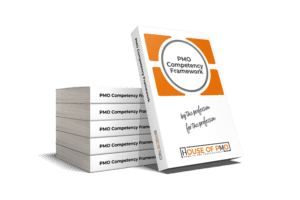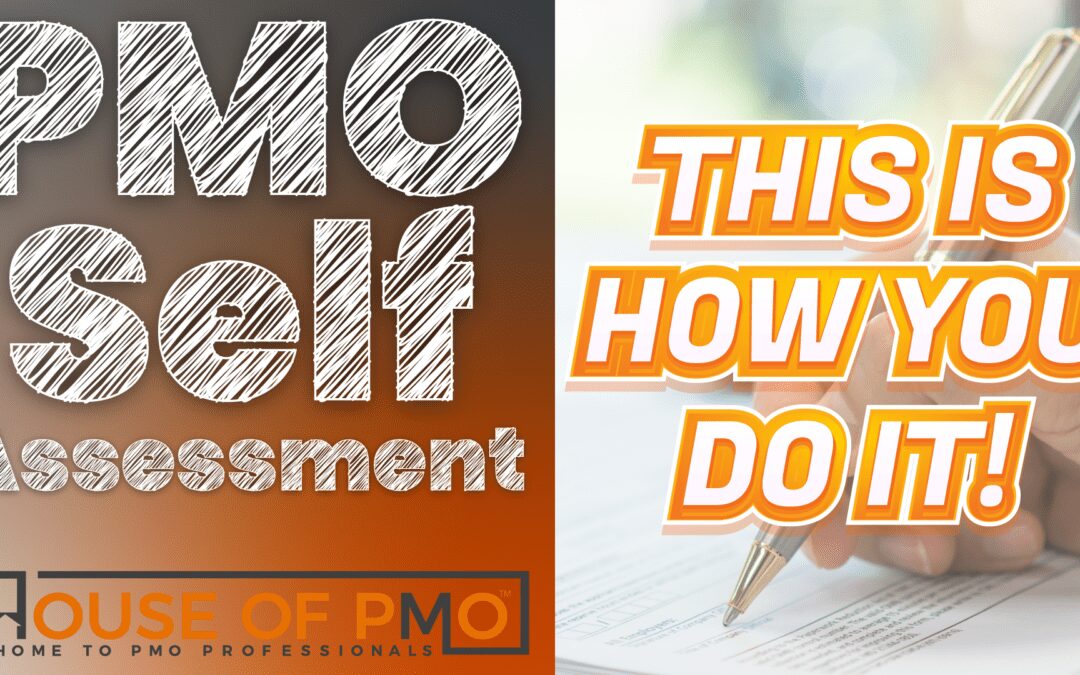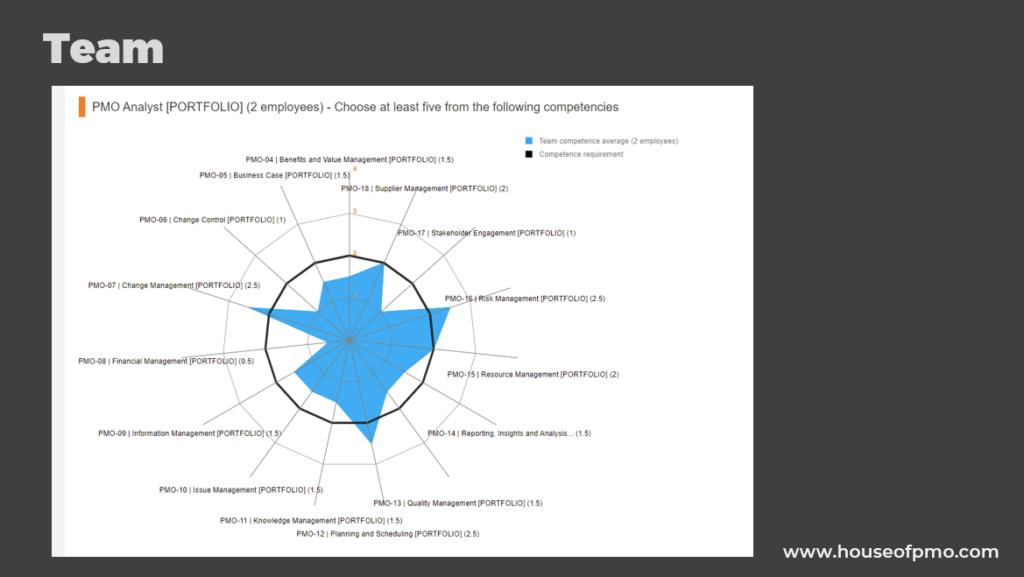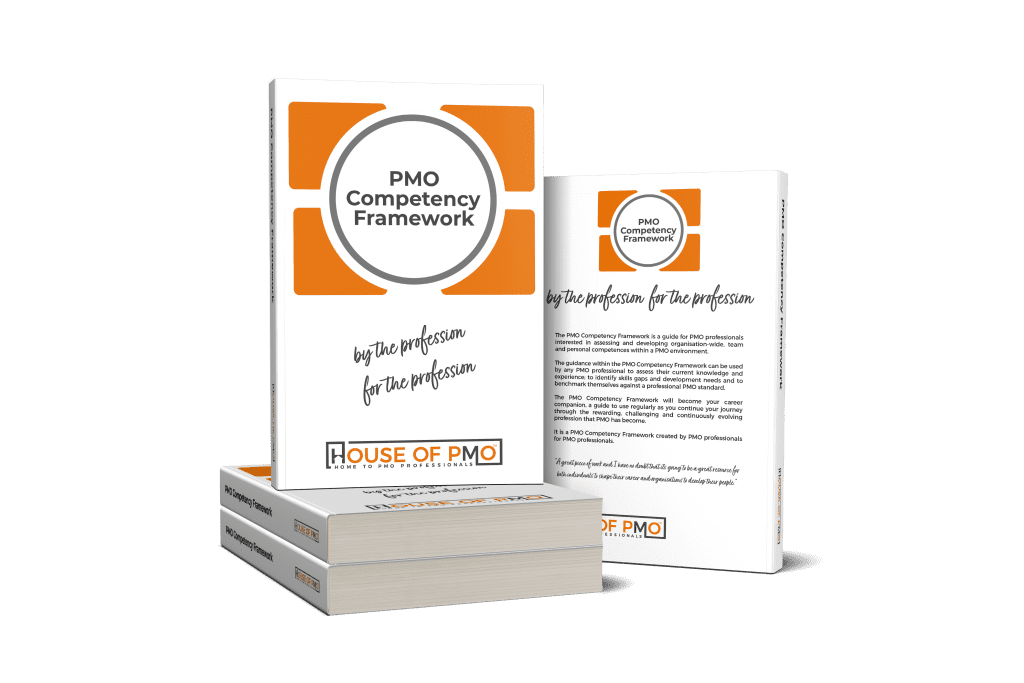The House of PMO delivered a recent session to PMO practitioners interested in taking more ownership in their professional development with the use of self-assessments.
The self-assessments became possible for PMO practitioners for the first time with the launch of the PMO Competency Framework in 2021 and members at the House of PMO today enjoy the membership benefit of accessing and using the self-assessment online tool.
 To be able to carry out a PMO self-assessment you need the PMO Competency Framework. The Competency Framework lays out all the different competences, knowledge, skills and behaviours you need to perform your PMO role competently.
To be able to carry out a PMO self-assessment you need the PMO Competency Framework. The Competency Framework lays out all the different competences, knowledge, skills and behaviours you need to perform your PMO role competently.
A self-assessment – or self-evaluation – allows you to score your own experience against those in the Framework.
In the session we also included advice on how to approach your self-assessment and also give a demonstration of the online version of the self-assessment tool which is available to all full members of the House of PMO.
The recording is now available for all PMO practitioners who are interested in learning more about self-assessments and how they can benefit your PMO career.
The Recorded Session
The Presentation Deck
>> Download the deck used in this session
Top Five Takeaway from the Session
 Carrying out a self-assessment requires time and reflection. It’s about taking ownership of your career so requires your investment to get the best out of them. Preparation is the key – putting time aside, not just to do the initial self-assessment but also the ongoing commitment to keep it updated. Throughout your career there will be special moments, times when you’ve carried out new tasks or carried out pieces of work that have challenged and stretched you. Those times are the ideal times to update your self-assessment.
Carrying out a self-assessment requires time and reflection. It’s about taking ownership of your career so requires your investment to get the best out of them. Preparation is the key – putting time aside, not just to do the initial self-assessment but also the ongoing commitment to keep it updated. Throughout your career there will be special moments, times when you’ve carried out new tasks or carried out pieces of work that have challenged and stretched you. Those times are the ideal times to update your self-assessment.
 With the PMO Competency Framework you can choose to carry out a self-assessment against different criteria. For example, you can choose to assess yourself against one of the four roles – Administrator, Analyst, Manager or Director. You can also assess yourself against a mixture of roles too – such as Analyst and Manager. You can also choose to assess yourself against the type of PMO you’re working in – so Project, Programme, Portfolio and Centre of Excellence. Again, you can assess against some or all of them.
With the PMO Competency Framework you can choose to carry out a self-assessment against different criteria. For example, you can choose to assess yourself against one of the four roles – Administrator, Analyst, Manager or Director. You can also assess yourself against a mixture of roles too – such as Analyst and Manager. You can also choose to assess yourself against the type of PMO you’re working in – so Project, Programme, Portfolio and Centre of Excellence. Again, you can assess against some or all of them.
In the demo we also showed how you can assess yourself based on where you are today – and where you’d like to get to in the coming months or years. You can of course assess yourself against the whole competency framework too.
In addition to the competences, you can also assess yourself against the knowledge, skills and behaviours that are also needed to perform competently in a role.
 People use self-assessments for a number of different reasons. One example is to understand where their strengths and weaknesses are. Using the online tool gives a downloadable report which includes spider diagrams to give that quick view (see below). Other examples include using them to help select where self-development is needed; they can also help boost confidence and motivation (especially using the time travel function that shows the changes you make in your self-assessment over time); they’re also good as a conversation starter with your manager (brilliant in performance evaluation sessions).
People use self-assessments for a number of different reasons. One example is to understand where their strengths and weaknesses are. Using the online tool gives a downloadable report which includes spider diagrams to give that quick view (see below). Other examples include using them to help select where self-development is needed; they can also help boost confidence and motivation (especially using the time travel function that shows the changes you make in your self-assessment over time); they’re also good as a conversation starter with your manager (brilliant in performance evaluation sessions).
 Being able to reflect on your experiences really makes a difference to your self-assessment. There are a number of different approaches and frameworks you can use and we show an exmaple based on the Bassot cycle (see below for more on that Cycle). Self-reflection has always been considered to be something practitioners do to help themselves do better in their chosen profession (the nursing profession is a great case in point).
Being able to reflect on your experiences really makes a difference to your self-assessment. There are a number of different approaches and frameworks you can use and we show an exmaple based on the Bassot cycle (see below for more on that Cycle). Self-reflection has always been considered to be something practitioners do to help themselves do better in their chosen profession (the nursing profession is a great case in point).
We liked the Bassot Cycle because of the Theory part. It’s the encouragement to seek out external good practice or do some further reading or studying about something which was specific to the experience you are reflecting on.
 Combining a PMO team’s self-assessments opens up new possibilities. Although the session focused mainly on individuals doing their own self-assessments, the team analysis view also raised interest (see below). It is useful to see where the team’s strengths are – and will raise questions such as, do these strength areas match our core service offerings. The weaknesses – or skills gaps can be discussed and addressed – perhaps more team training might be required, or actually the gaps are fine for now because the PMO doesn’t offer those services (such as financial management shown below)
Combining a PMO team’s self-assessments opens up new possibilities. Although the session focused mainly on individuals doing their own self-assessments, the team analysis view also raised interest (see below). It is useful to see where the team’s strengths are – and will raise questions such as, do these strength areas match our core service offerings. The weaknesses – or skills gaps can be discussed and addressed – perhaps more team training might be required, or actually the gaps are fine for now because the PMO doesn’t offer those services (such as financial management shown below)
Team assessments are available for corporate members which some might find useful to explore further.
Further Resources
If you have been inspired to take your own self-assessment you have a couple of choices.
- You can purchase the PMO Competency Framework book and do your assessment with the book
- You can become an online or full member and gain access to the online version which is part of your membership benefit. You can take those steps here.
To get started, you can access further videos and guides in the members areas here.






